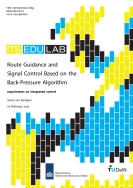Bad traffic conditions can be improved by regulating traffic demand and network capacity. Dynamic Traffic Management (DTM) systems allocate temporal and spatial utilization of infrastructures and vehicle fleets by means of dynamic signals. By timely response to changing traffic conditions DTM goals, in terms of effective, safe and reliable use of the infrastructure, can be met. Two important trends in the field of DTM are: a shift from local control measures towards network-wide control and a shift from collective traffic information towards individual advice. Individual advice can be transmitted via in-car technology, however, up until now in-car systems are typically used to improve the (route) choice of the individual road user, whereas DTM aims at improving the network performance as a whole. Network-wide traffic control is complicated by the dynamic nature of traffic itself and the dynamic effects of control measures, especially if the network and DTM structure is complex. Route guidance can make a significant contribution to network-wide DTM. Using in-car navigation to transmit individual directions, it is expected to improve the network performance (better use of the available capacity, higher throughput and stability, and less spill-back), and reduce the travel time for the individual road user as well. Finding the right route guidance configuration is a complex task, that should take potential unfavourable effects and coordination into account. Moreover, integrating traffic signal control at intersections with route guidance is a logical step. The main objective of this thesis is to develop a framework that integrates route guidance and signal control based on the back-pressure principle, and determine its feasibility and potential benefit.
A general back-pressure algorithm for traffic signal control has been designed, with two main variants: one with a fixed cycle time that assigns phase durations for one or more cycles, and one with short time slots that repeatedly activates the dominant phase. For route guidance a general algorithm has been proposed as well. Furthermore a number of variants for the algorithm have been considered and simulated. The simulation environment is based on the macroscopic simulation model DSMART. The simulation experiments are divided into three parts: case 1 examines traffic signal control, case 2 focuses on route guidance, and case 3 combines traffic signal control and route guidance. For traffic signal control, back-pressure control is a good way to generate high throughput at the intersections, while keeping the queues evenly distributed and within boundaries. For route guidance an optimal use of back-pressure has not yet been found, as the results are on a most part lacking compared to the standard route choice model.
In conclusion, this thesis demonstrates that traffi›c signal control based on back-pressure control performs well in the simulations, especially the variant with time slots. Throughput is high and queues remain within reasonable boundaries. It is difficult to fully integrate traffic signal control and route guidance. A logical step would be to use route guidance settings to determine the necessary turning probabilities at the intersection. Using back-pressure for route guidance requires (artificial) design choices. The challenge is to define a representative function of route pressure or utility, and to combine this with a service rate value, in order to obtain a high throughput and stability with minimum delays. Several ideas have been presented. Future research is recommended on the fine-tuning of the back-pressure traffic signal model, and on further integration and coordination of the control strategies. On the part of route guidance, especially finding representative route pressure values and making the model applicable of larger networks (distributed approach) require more research. The control approaches should further be simulated and tested with a microscopic simulation model, on more networks and scenarios. Necessary developments for a practical use include the availability of in-car systems and traffic state estimation.
